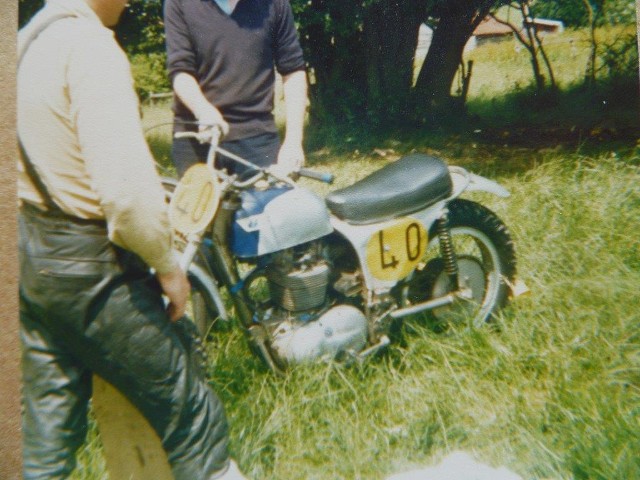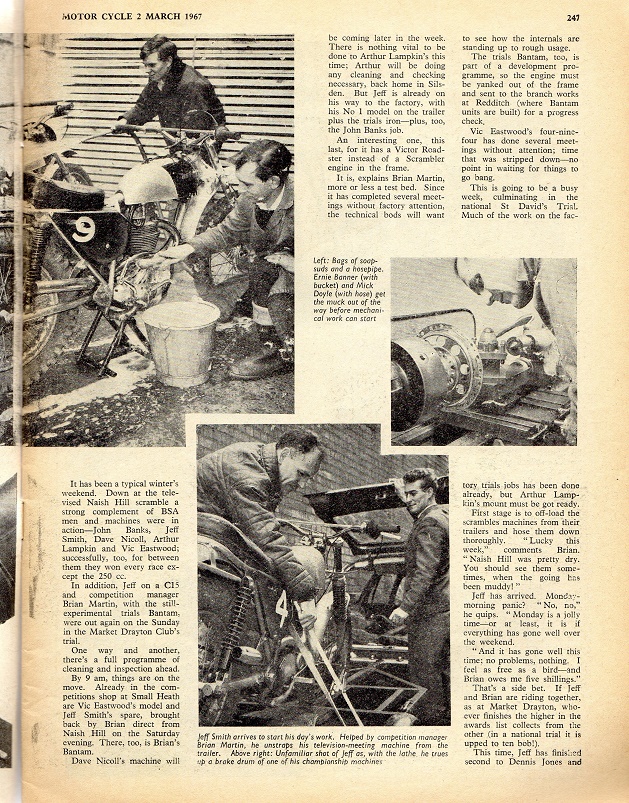BACK TO 1965/6
See the article below. The surprise here is that this bike came out prior to the titanium bike in 1966 - it has a new
steel, lightweight frame, GP forks and the new 498cc "works" engine that was used (with one major revision) by the main works riders until the
Competition Department closed. The full works engine was built on magnesium castings and was not, initially, reliable. It had a different
bore/stroke to the 440 and different cylinder stud spacings. It had a "pear" shape - a nice looking motor. The early 440s crankcases were sandcast
aluminium and some of these cases were used for the "economy" works engines that had the pear shaped head/barrel grafted on - the castings
were generous enough to take the bigger stud spacings - and the engines were supposed to produce more power - thicker/stiffer but heavier.
Not all the works riders got magnesium cased engines.

In passing, Graham mentioned that he thought there was a GP frame with a B50 swinging arm arrangement - just idly flicking through "Rolling
Thunder" there is a picture of Alan Clews' GP - and guess what - it has that arrangement!

Picture above - Graham Horne with Smithy's bikes - somewhere in Germany! On the way back in I think 1967.

Lo and behold! a picture ( taken by Barry Colson) of a GP with a B50 type swinging arm at Brands Hatch in early 1966.
Bernard Singleton
I finally got to meet the great man himself. On approaching his house you think to yourself that this is the home of a former race
mechanic to a world champion - even though he had a stroke in 2014 , 18 months later he has forced his body back to somewhere
near normality and his house and large garden are immaculate. His eye for detail is still there and he was spotting things on a bike
we took for him to see like the wrong sprocket size, the wrong spool hub and the correct floating front brake cam.
He is full of stories about life on the GP circuit in 1966 and later.
I asked him what used to break on the bikes - everything was the rejoinder. The first magnesium crankcases were forever breaking.
They tried all sorts of solutions such as bolting steel plates throuch the lugs. The gearbox output bearings and the engine main
bearings were "bolt-in". Eventually an extra lug was welded on the frame and the engine plates extended to pick it up and spread
the load.
There was also some re-working of the head and barrel and engine dimensions. Those engines persisted right to the
end although a few riders were using B50 engines latterly. There were a few B50 type (large rear engine lug) cases cast in
magnesium - some of them used in the U.S. as 250s.
Back in the day, travelling the continent Bernard and Smithy would set out with just one bike and an enormous ammunition box full
of spares that was as wide as the A55 they travelled in. Sometimes they had company - Arthur Lampkin or Jerry Scott - sometimes
alone. They might not talk for days, not because of any problem, just that there wasn't anything to say.
Travel behind the iron curtain was "interesting". In some places you weren't allowed to travel at night so if you hadn't found
somewhere decent you had to stay where you found yourself and sleep on a barn floor .
They arrived at a railway crossing which had armed guards who, because a train was due kept them waiting for 4 hours in case the
train came while they were crossing. Arthur even urinated accross the track to indicate the distance involved and the stupidity of it all
but they weren't allowed to cross until the train had passed and gone completely out of sight. The roads were dirt in the main.
Some trips to Russia were by train from Vienna - so the bike and spares were loaded on the train and a vehicle would meet them at
the other end to take them to the destination - accomodation was always good.
One of the journeys is described in Ken Sprayson's wonderful book.
Another story concerning magnesium cases was at , Bernhard thinks, the Italian GP, the cylinder studs pulled out of the cases and the
barrel was going up and down with the piston. Smithy was all for throwing the bike on the trailer and going home but Bernhard got a
piece of hard wood and hammered it between the head and the frame and fixed it with a woodscrew. I don't know whether he won
but the bike lasted the meeting - is there a frame out there somewhere bearing the evidence?
One of the interesting things Bernard confirmed was that once a works bike went back into the Comps Shop it could be ripped to
bits and the only original bits returned to the rider were the handlebars and footrests.

Magnesium cases with bolt-through support.

Bolt-on gearbox output bearing

This bike competed at an early Bonanza . It is one of the titanium bikes - where is it now?


A somewhat mullered titanium front brake backplate - pics thanks to one of our GP owners




The 1968 version with Magura levers, high level mudguard, titanium yokes, 2 bolt magnesium forks, 7" half sided brake, scalloped headstock
(with sticker covering the hole), black tank panel (replacing the blue of the Queens Industry award), comfy seat, carburettor in the airbox, new
fibreglass airbox and side panels, inverted brake pedal, odd markings on primary drive cover, extended rear engine plate.


